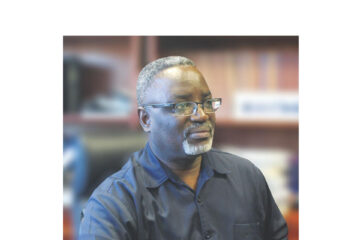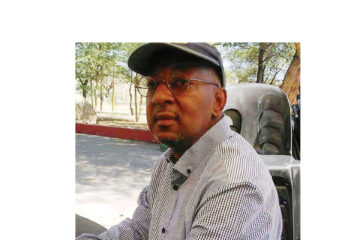Vivian !Nou-/Gawaseb and McClay Thikusho
The need of adopting the circular economy’s principles becomes evident when we try to reimagine a sustainable future for Namibia.
The circular economy is an economic model that emphasises the recycling and repurposing of materials and goods, particularly as a strategy to maintain ecologically responsible or sustainable production.It offers a paradigmshifting strategy that not only encourages economic development but also ensures social advancement and preservation of the environment. Prioritising and allocating resources to theprogress of circularity is becoming more and more important, especially in the context of Namibia. This specifically applies to important industries including waste management, agriculture, oil & gas,
and energy. Embracing a circular economy framework not only fosters sustainability and resilience but also offers a multitude of benefits to the economy at large. In this opinion piece, we will explore the immense potential of the circular economy for Namibia, emphasizing its ability to create a sustainable and prosperous future.
Circular Economy:
The circular economy offers a promising framework to address the challenges we face while fostering sustainable development. Unlike the traditional linear economy, which follows the take-make-dispose model, the circular economy aims to maximize resource use efficiency, minimize waste generation, and promote circular flows of materials and energy. In Namibia, this means transitioning from a linear, consumption-oriented society to one that embraces the principles of reduce, reuse, recycle, and regenerate. By implementing circular economy practices, we can minimize waste, conserve resources, and reduce our environmental footprint while simultaneously creating economic opportunities and enhancing social well-being. One of the key aspects of the circular economy is the establishment of local value chains. Creating value chains entails designing and implementing systems that maximize the value of resources and commodities throughout their lifespan while reducing waste and environmental effect. Mapping the value cha
in and redesigning products and services is important. Furthermore, it is important to apply eco-design and product innovation concepts to create more sustainable goods and services that enable circularity. Another alternative is Reverse Logistics and Take-Back Systems, which are systems that gather, recover, and recycle items and materials at the end of their useful life. Advocating for supporting policies and laws that foster circular activities and eliminates barriers where they exist becomes crucial. Namibia possesses a diverse range of natural resources, such as minerals, agriculture, and an enormous renewable energy potential. By integrating these resources into circular value chains, we can maximize their value and invariably minimize dependence on imported goods. For instance, in the agricultural sector, embracing circular practices such as organic farming, composting, and sustainable irrigation methods can enhance productivity while reducing chemical inputs and waste water. By promoting local product
ion and consumption, we can bolster our food security, create employment opportunities, and reduce our reliance on imports.
Beyond Challenges:
Namibia, is faced with pressing challenges in the form of waste generation, resource scarcity, and increasing environmental degradation. Rapid urbanization and industrialization have exacerbated these issues, demanding immediate action and innovative solutions. However, within these challenges lie opportunities to transform our economy and transition to a more sustainable model. Identifying the challenges that the country faces towards transitioning towards more circular economic approaches is imperative. Challenges are mainly that there is a lack of promotion of behavioural change and supporting the adoption of circular principles, it is critical to educate and raise awareness about the benefits and practices of circularity to all Namibians, in order to transition to a circular economy. The lack of robust infrastructure is another obstacle the circular economy faces, because in order to have a more circular economy, adequate infrastructure needs to be in place for the management of waste, facilities used for
recycling and generating energy. To have such robust infrastructure there needs to be adequate planning and significant investments in place, with a more specific focus on regions that have low economic development and enhancing their competitive advantage. There needs to be a great collaborative engagement and effort from all stakeholders at all levels, such as governmental institutions, individuals, communities, consumers, and industry players from all enterprises. Aligning interests, forming alliances, partnerships and guaranteeing efficient coordination might be difficult, but it is essential for the successful implementation and execution of circular strategies.
Opportunities arise as a result of employing renewable energy sources such as green hydrogen, solar and wind power. Adopting circular methods in the energy sector can lead to better resource efficiency. This invariably lessens dependency on scarce resources while simultaneously contributing to long-term energy security.
Circularity in the oil and gas industry can result in cost savings through optimizing resource extraction, production, and refining operations. Companies may cut operating expenses and increase overall profitability by avoiding waste and maximizing resource use.
Circular principles provide the possibility of hastening the transition to renewable energy sources. Since Namibia is going through energy transition, this transition has the potential to develop new companies, job opportunities, and investments in clean energy technology, establishing Namibia as a pioneer in sustainable energy generation.
Waste management provides several potentials for circularity as well. Promoting garbage recycling and reprocessing can lead to the growth of recycling industries and the production of secondary raw materials. As a result, demand for virgin resources is reduced, energy is conserved, and economic growth is stimulated.
Sustainable Innovation:
Transitioning to a circular economy requires innovation, collaboration, and the active participation of multiple stakeholders, through facilitating the creation of new technologies, processes, business models and innovation acts as a catalyst for circular practices. It promotes the development of sustainable alternatives. Eco-design, product-service systems, and sophisticated recycling technologies are reshaping businesses by enabling for resource efficiency, waste reduction, and the creation of new value streams. Embracing circularity frequently demands the use of cutting-edge technology and techniques. This may provide difficulties for companies and nations without the required skills, money, or access to technical advancements. To solve these problems, collaboration and knowledge sharing is essential. Open communication and information sharing enable the replication of successful models, the discovery and identification of hurdles and barriers, and community problem-solving, all of which contribute to the
broad adoption of circular practices. It is crucial to foster partnerships between the government, private sector, civil society, and academia to drive sustainable change. Policymakers can create an enabling environment by implementing supportive regulations, incentives, and promoting research and development. Additionally, investment in education and awareness campaigns is vital to ensure that all citizens understand the importance of the circular economy and their role in its implementation. By fostering a culture of sustainable practices, we can empower individuals and communities to become active participants in the transition.
Conclusively, Namibia stands at a critical juncture, where embracing the principles of the circular economy can pave the way for a sustainable and prosperous future. By aligning our economic activities with the principles of reduce, reuse, recycle, and regenerate, we can unlock significant environmental, economic, and social benefits. The circular economy offers a holistic approach that balances economic growth with environmental protection and social well-being. It provides an opportunity to create a resilient and inclusive society for all Namibians, where sustainable practices and the promise of a better future go hand in hand. Let us seize this opportunity to unlock the full potential of Namibia’s circular economy and shape a brighter tomorrow. By prioritizing the circular economy, we can transform our nation into a role model for other nations, where sustainable practices are ingrained in our way of life. Together, let us work towards a circular economy that not only benefits us today but also ensures a s
ustainable legacy for future generations
Vivian !Nou-/Gawaseb is a town & regional planning technician based in Namibia. He is currently pursuing a postgraduate degree in the latter field and writes on spatial planning, urban governance and sustainable development.
McClay Thikusho is an architectural technologist and a staunch advocate for sustainable design and the circular economy. With a Bachelor’s degree in Architecture, McClay possesses a deep-rooted passion for the built environment, green technology, and energy efficiency in buildings.




